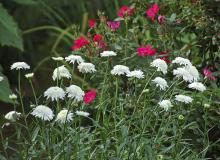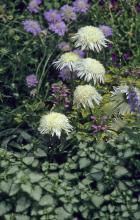Information Possibly Outdated
The information presented on this page was originally released on June 18, 2009. It may not be outdated, but please search our site for more current information. If you plan to quote or reference this information in a publication, please check with the Extension specialist or author before proceeding.
Ice Star Shasta looks like coconut topping
By Norman Winter
MSU Horticulturist
Central Mississippi Research & Extension Center
It’s easy to love Shasta daisies, but when they look like shredded coconut on top of round cupcakes, they seem good enough to eat.
Last week we filmed a Southern Gardening segment in Mississippi’s hot Delta at the Wister Gardens in Belzoni. It’s called The Delta’s Garden, but the readers of Mississippi Magazine recently honored Wister as Mississippi’s Best Garden.
There in the gardens the daylilies were doing their part to steal the show, but there was one combination I found absolutely riveting. The Ice Star Shasta daisy was paired with Knockout shrub roses.
If you’ve never seen Ice Star, you might not recognize it as a Shasta. Shasta daisies are among the most loved perennials in the country, and they are included in more weddings than you can imagine.
It’s odd that we talk so much about varieties of other perennials but go generic when it comes to the Shasta. In recent years we’ve seen new selections like Angel Daisy and Darling Daisy; Becky was recently selected Perennial Plant of the Year.
Other popular selections are Snow Cap and the dwarf selections Silver Princess, Little Miss Muffet and Snow Lady, the All-America Selections winner. But the Ice Star takes honors for being the most unique-looking Shasta selection.
Shasta daisies have the potential to be around for a long time, so it really pays to prepare your soil. Choose a site with at least six hours of sunlight. In the South, the flowers should get a little late afternoon shade during the heat of the day.
The soil should be fertile and well-drained; soggy conditions in summer or winter simply will not work. If you have tight, heavy clay, incorporate 3-4 inches of organic matter like compost or humus and work your soil to a depth of 6-8 inches.
Shastas are great about giving you more plants, so divide in the fall, spacing them 12-15 inches apart. Make this a yearly ritual to keep those glorious blooms coming at their best.
There are lots of landscape possibilities besides combining them with Knockout roses. Another garden I saw featured them with Harlequin Blue scabiosa, or pincushion flower, and Beacon Silver lamium.
The lavender-blue partner Harlequin Blue scabiosa is no slouch, producing blossoms that are almost as intricate as Ice Star’s blooms. Gardeners are beginning to realize the groundcover-like ability of the Beacon Silver lamium, which has showy variegated silver leaves with green margins and light purple flowers.
Shasta daisies are cold hardy from zones 4-10, which means most of the country can relish in their beauty. You may be asking yourself why you don’t already have Shasta daisies. While I will decline from pointing fingers lest I look in the mirror, the answer may lie in our desire for instant gratification.
Shasta daisies are most often sold as healthy, green transplants that will turn into majestic beauties later in the season. This is really how we should buy all of our perennials, but the desire for instant color leads us down another path.
While varieties like Ice Star may be for the connoisseur, the Shasta daisy is certainly a great choice for the garden.




